
There is perhaps no other group of animals on Earth that evokes more fear in the mind of man than the sharks. They are viewed as vicious man-eaters and are slaughtered the world over in an attempt to make the seas safe for humans. But of the hundreds of different species of sharks in the ocean, only a small handful pose any threat to man. Humans do not appear to be on the menu for sharks. It is thought that most shark attacks are a case of mistaken identity. A diver in a wet suit looks a lot like a sea lion, a favorite food for some of the larger sharks. The fact is that more people are killed by lightning each year then by sharks. Public fear and ignorance of these magnificent animals has led to many species being hunted and killed in large numbers. They have almost disappeared in some parts of the world. Sharks one of evolution's most perfect creations. Many of them have not changed in millions of years. They have evolved into the perfect hunting machine. Sharks are part of a family of fishes known as cartilage fishes. They have no bones in their bodies, only cartilage, like the soft flexible tissue in the end of your nose. Rays are also a member of this group. In fact, rays are actually nothing more than flattened out sharks. They are the "birds" of the sea. They can be seen flying gracefully through the water as effortlessly as a bird flies through the air. Some rays are capable if inflicting painful stings with their tails. Others, such as the giant manta, can grow to enormous proportions but are completely harmless to man. Below is a listing of some of the more common sharks and rays found in the world's coral reefs.
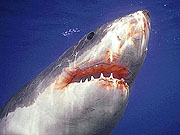
Few animals inspire more fear in the mind of man than the great white shark. It is an aggressive and ruthless hunter, and in many ways, is the ideal predator. This shark has been known to grow to over 25 feet in length. The great white is very common in the Pacific Ocean. They will eat almost anything, but prefer to dine on sea lions and other marine mammals. Unfortunately, human ignorance and fear has contributed to the decline of this magnificent animal in the wild.
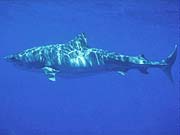
The tiger shark is another ferocious predator. It is second only to the great white in its size and reputation as a killer. Tigers can grow to a length of over 16 feet. This shark has a big head, blunt snout, and gets its name from the stripe marks on its body. This dangerous shark will eat almost anything, and has been known to attack humans.
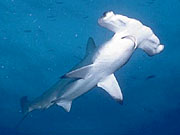
The scalloped hammerhead is just one of several species of sharks that are characterized by a large hammer-shaped head. The shark's eyes are located on either end of this wing-like structure. This shark grows to a length of 14 feet, and feeds mainly on small fish and invertebrates. It is an aggressive species and has been known to attack humans.
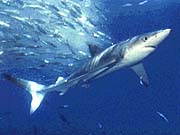
The blue shark is a slender species that gets its name from the bright blue color of its tail and fins. It can be identified by its long, thin body and long, conical snout. The blue is one of the most common sharks in the sea, and is found in many parts of the world. They are often seen swimming lazily at the surface, but have also been seen at depths of over 1600 feet.
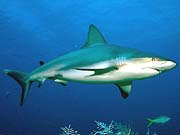
The gray reef shark is one of the major predators on the coral reef. Its highly streamlined body allows it a great deal of speed and maneuverability in the water. The gray reef is a very aggressive species, and is commonly seen in the classic "feeding frenzy" film footage. This shark can be identified by the black markings on its pectoral and tail fins.
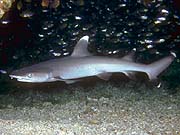
In startling contrast to the gray reef shark, the whitetip reef shark is a timid and unaggressive species. This shark is commonly found near the floor of the coral reef, where it feed mainly on small fish, octopus, lobster and crabs. The whitetip grows to a length of 5 feet, and can be identified by the white markings on the tips of its fins.
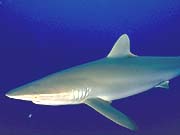
The silky shark gets its name from the fact that, unlike most sharks, it has an unusually smooth skin. It is one of the most common sharks in the open ocean. The silky shark is a relatively small species. This shark also exhibits unique trait. It can be temporarily immobilized by turning it over on its back.
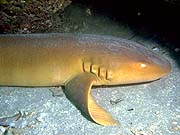
The nurse shark is a very docile and unaggressive species. It is a sluggish bottom feeder, and it uses its pavement-like teeth to crush shellfish. The Nurse Shark is commonly seen lying motionless on the ocean floor. It grows to an average length of 8 feet. Although any wild animal can be dangerous if cornered, the nurse shark is not considered a threat to man.
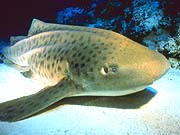
The shy and harmless leopard shark is a favorite among aquarium hobbyists. This shark gets its name from its leopard-like spots. It grows to a length of 5 to 6 feet, and is often found resting on sandy ocean bottoms. The leopard shark is ovoviviparous, meaning the mother shark hatches its eggs inside her body and then gives birth to between 4 and 30 live pups.
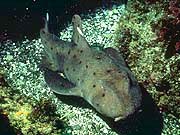
The horn shark is a small, timid species that grows to a length of about 4 feet. It is nocturnal, hiding under rocks during the day, becoming active at night. This shark poses no threat to humans and can be easily approached. The horn shark is common in Pacific waters, where it feeds on sea urchins, abalone, bony fish, and crustaceans.
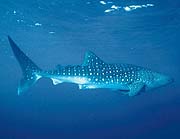
The whale shark is one of the largest of all the shark species. In fact, it is the largest fish in the world, growing to a length of over 40 feet. In spite of its huge size, however, the whale shark is completely harmless. This shark uses special organs in its gill bars to filter microscopic plankton from the water. It can be found throughout most of the world's tropical and temperate oceans.
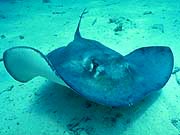
The southern stingray is one of the more common stingray species along the Atlantic coast of the United States. The tail of this species carries one or two sharp spines, which can deliver a powerful toxic sting. This ray is a bottom feeder, and is often found buried in the sand along the ocean floor.
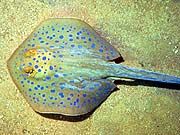
The blue spotted stingray is a common favorite with aquarium owners. This is a beautiful species, with brightly colored blue spots on its body. It is a relatively small ray, and can usually be kept successfully in an aquarium environment. This ray can be found on sandy ocean bottoms near coral reefs throughout the Indo-Pacific from the Red Sea to southern Australia.
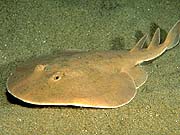
The lesser electric ray is a species that is capable of producing a powerful electric shock. This animal can produce between 14 and 37 volts, enough to give a diver a strong jolt. The ray uses this special ability to stun its prey as well as for defense from predators. It feeds on small bottom-dwelling invertebrates. The lesser electric ray is found in the western Atlantic Ocean from North Carolina to Argentina.
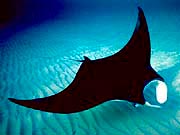
There are few sites in the ocean as beautiful as the graceful flight of the manta ray through the clear, blue waters. This magnificent animal can have a wingspan in excess of 15 feet. Although this animal is also called the devil ray, it is completely harmless to humans. Unlike its stingray cousins, the manta ray has no sting. Manta rays feed mainly on plankton and small schooling fish.
Sponges & Sea Squirts | Corals & Anemones | Sea Worms | Echinoderms
Crustaceans | Mollusks | Coral Reef Fishes | Unusual Reef Fishes
Sharks & Rays | Marine Reptiles | Marine Mammals